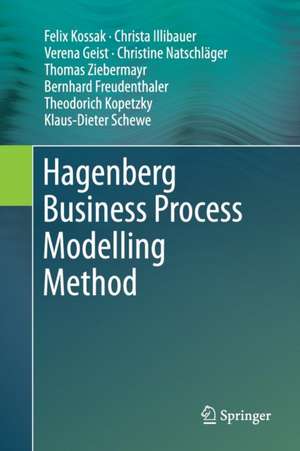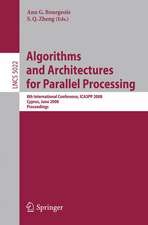Hagenberg Business Process Modelling Method
Autor Felix Kossak, Christa Illibauer, Verena Geist, Christine Natschläger, Thomas Ziebermayr, Bernhard Freudenthaler, Theodorich Kopetzky, Klaus-Dieter Scheween Limba Engleză Paperback – 27 mai 2018
Based on a purified Business Process Model and Notation (BPMN) variant, the authors present proposals for several important issues in BPM that have not been adequately considered in the BPMN 2.0 standard. It focusses on modality as well as actor and user interaction modelling and offers an enhanced communication concept. In order to render models executable, the semantics of the modelling language needs to be described rigorously enough to prevent deviating interpretations by different tools. For this reason, the semantics of the necessary concepts introduced in this book are defined using the Abstract State Machine (ASM) method. Finally, the authors show how the different parts of the model fit together using a simple example process, and introduce the enhanced Process Platform (eP2) architecture, which binds all the different components together. The resulting method is named Hagenberg Business Process Modelling (H-BPM) after the Austrian village where it was designed.
The motivation for the development of the H-BPM method stems from several industrial projects in which business analysts and software developers struggled with redundancies and inconsistencies in system documentation due to missing integration.
The book is aimed at researchers in business process management and industry 4.0 as well as advanced professionals in these areas.
| Toate formatele și edițiile | Preț | Express |
|---|---|---|
| Paperback (1) | 644.33 lei 6-8 săpt. | |
| Springer International Publishing – 27 mai 2018 | 644.33 lei 6-8 săpt. | |
| Hardback (1) | 650.59 lei 6-8 săpt. | |
| Springer International Publishing – 9 mai 2016 | 650.59 lei 6-8 săpt. |
Preț: 644.33 lei
Preț vechi: 805.41 lei
-20% Nou
Puncte Express: 966
Preț estimativ în valută:
123.29€ • 129.42$ • 102.33£
123.29€ • 129.42$ • 102.33£
Carte tipărită la comandă
Livrare economică 10-24 aprilie
Preluare comenzi: 021 569.72.76
Specificații
ISBN-13: 9783319808253
ISBN-10: 3319808257
Ilustrații: XII, 259 p. 57 illus., 28 illus. in color.
Dimensiuni: 155 x 235 mm
Greutate: 0.39 kg
Ediția:Softcover reprint of the original 1st ed. 2016
Editura: Springer International Publishing
Colecția Springer
Locul publicării:Cham, Switzerland
ISBN-10: 3319808257
Ilustrații: XII, 259 p. 57 illus., 28 illus. in color.
Dimensiuni: 155 x 235 mm
Greutate: 0.39 kg
Ediția:Softcover reprint of the original 1st ed. 2016
Editura: Springer International Publishing
Colecția Springer
Locul publicării:Cham, Switzerland
Cuprins
1 Introduction.- 2 Deontic Process Diagrams.- 3 A Layered Approach for Actor Modelling.- 4 A Typed Approach to User Interaction Modelling.- 5 An Enhanced Communication Concept.- 6 Horizontal Model Integration.- 7 Formal Specification of the eP 2 Architecture.- 8 Summary and Outlook.- A List of Acronyms.- Index.
Recenzii
“The book will interest researchers and even practitioners in the consultancy business who work in the field of business process management and modeling and workflow definition. It is worth studying for those who look for more accurate, usable, and user-friendly solutions for defining automated workflows and business processes.” (Bálint Molnár, Computing Reviews, November, 2016)
Notă biografică
The authors are experienced industrial researchers in the field of computer science and software engineering, with experience in business process modelling and formal methods in particular. They have been working in a common team at the Software Competence Center Hagenberg (SCCH) in Austria.
Textul de pe ultima copertă
This book presents a proposal for designing business process management (BPM) systems that comprise much more than just process modelling.
Based on a purified Business Process Model and Notation (BPMN) variant, the authors present proposals for several important issues in BPM that have not been adequately considered in the BPMN 2.0 standard. It focusses on modality as well as actor and user interaction modelling and offers an enhanced communication concept. In order to render models executable, the semantics of the modelling language needs to be described rigorously enough to prevent deviating interpretations by different tools. For this reason, the semantics of the necessary concepts introduced in this book are defined using the Abstract State Machine (ASM) method. Finally, the authors show how the different parts of the model fit together using a simple example process, and introduce the enhanced Process Platform (eP2) architecture, which binds all the different components together. The resulting method is named Hagenberg Business Process Modelling (H-BPM) after the Austrian village where it was designed.
The motivation for the development of the H-BPM method stems from several industrial projects in which business analysts and software developers struggled with redundancies and inconsistencies in system documentation due to missing integration.
The book is aimed at researchers in business process management and industry 4.0 as well as advanced professionals in these areas.
Based on a purified Business Process Model and Notation (BPMN) variant, the authors present proposals for several important issues in BPM that have not been adequately considered in the BPMN 2.0 standard. It focusses on modality as well as actor and user interaction modelling and offers an enhanced communication concept. In order to render models executable, the semantics of the modelling language needs to be described rigorously enough to prevent deviating interpretations by different tools. For this reason, the semantics of the necessary concepts introduced in this book are defined using the Abstract State Machine (ASM) method. Finally, the authors show how the different parts of the model fit together using a simple example process, and introduce the enhanced Process Platform (eP2) architecture, which binds all the different components together. The resulting method is named Hagenberg Business Process Modelling (H-BPM) after the Austrian village where it was designed.
The motivation for the development of the H-BPM method stems from several industrial projects in which business analysts and software developers struggled with redundancies and inconsistencies in system documentation due to missing integration.
The book is aimed at researchers in business process management and industry 4.0 as well as advanced professionals in these areas.
Caracteristici
Presents the Hagenberg Business Process Modelling method, tackling issues not dealt with sufficiently in BPMN 2.0 Highlights actor and user modelling and enhanced communication Based on experiences in several industry 4.0 projects Includes supplementary material: sn.pub/extras
















